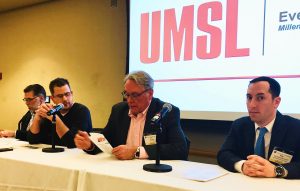Education on behalf of society, doctors, business owners needed to combat opioid crisis

By SHERI GASSAWAY
Correspondent
In 2016, Laborers Local 110 Business Manager Don Willey lost his 36-year-old son Matt who was battling addiction to a heroin overdose. The very next day, his 26-year nephew died from the same thing.
Since then, he’s turned his grief into action by becoming an advocate for opioid reform and recovery efforts. Willey shared his experience and moderated a panel discussion at the “Opioids and the Workplace” conference at the University of Missouri-St. Louis Jan.10, hosted by a coalition of Labor, community members and business leaders.
“As a father and the business manager of a construction local, the enormity of this epidemic is unimaginable,” he said. “Grief is a very physical, heavy emotion, and as a parent, to get caught up in the drama and the trauma just puts you in a tunnel vision. I want to take Matt’s life and make it mean something.”
According to the National Council on Alcoholism and Drug Abuse, there were 760 opioid-related deaths in the St. Louis region in 2017. That’s a seven percent increase from the year before and accounts for 70 percent of opioid-related deaths in Missouri.
STATUS QUO
ISN’T WORKING
“The status quo isn’t working,” Willey said. “The path to recovery is hard and difficult, but there are science-based and alternative methods that work. The key is education on the part of society, providers and business owners.”
Chad Sabora, executive director for the Missouri Network for Opiate Recovery and Reform who has been in recovery since 2011, said one of the first things that needs to change is how society views and talks about substance abuse disorder.
‘WE HAVE TO CHANGE
THE WAY WE LOOK
AT DRUG USERS’
“Calling them addicts and junkies does not help our cause,” he said. “We have to change the way we look at drug users and how we talk to them and about them and treat them with respect. We take all these terms and beat them up with them.”
Sabora said society also needs to change the way it engages people with substance abuse disorders and the theory that “you’ve got to wait until they hit rock bottom.”
 ENGAGE PEOPLE WHEN
ENGAGE PEOPLE WHEN
THEY ARE STILL USING
To drive home that point, Sabora asked another panelist, Dr. Evan Schwarz, an emergency room physician: “Would you wait until a person breaks every bone in their body until you treat a broken bone? Of course not. We need to start engaging people when they are still using whether they want to stop or not and help them to stay safe and survive long enough to enter recovery.
“I was at that point in my drug use at one time where I had no intention of stopping, but if you say ‘I understand that, but let’s treat your bi-polar disorder or prevent you from contracting hepatitis C or HIV.’ It creates a bond of trust, speeding up the process of them asking for help, and people are five times more likely to seek treatment.”
Dr. Thomas Gotsis, a dentist at the Midwest Dental Sleep Institute in St. Louis who has been sober since 1989, is trying to help physicians and dentists in the community learn about substance abuse disorder and teach them how to treat patients with acute pain. He visits dental schools to share that information with students.
‘EDUCATION HAS TO START
WITH HEALTH CARE’
“You should treat acute pain as acute pain and not overload patients with doses because either we (as doctors) don’t want to be bothered – and that’s a problem – or we don’t know how to handle addiction,” he said. “The education has to start with us health care pros.”
Dr. Schwarz, an associate professor of emergency medicine, medical toxicology section chief and director of the outpatient Medical Toxicology and Addiction Medicine Clinic at the Washington University School of Medicine, agreed with Gotsis that historically, not a lot has been done to teach students in medical school about addiction and recovery.
“Today, we are teaching them to treat patients with addiction like they have a medical illness like hypertension or diabetes and that it requires a medical practitioner and treatment plan,” he said.
 Schwarz also said physicians need to revisit the pain scale as the fifth vital sign. In the late 1990s and in early 2000, the CDC created the fifth vital sign,” establishing pain as a recognized vital sign equal to blood pressure, heart rate, respiratory rate and temperature.
Schwarz also said physicians need to revisit the pain scale as the fifth vital sign. In the late 1990s and in early 2000, the CDC created the fifth vital sign,” establishing pain as a recognized vital sign equal to blood pressure, heart rate, respiratory rate and temperature.
REEVALUATE PAIN
“If you are giving someone that pain scale of zero to 10 with 10 being the worst pain, you’re insinuating that the pain score should be zero,” he said. “We need to change the discussion with the patient so instead of giving someone 70 pain pills for a broken finger, we need to reevaluate that policy and say ‘Hey, we’re going to make that pain tolerable and then it’s going to hurt for a couple days.’”
ALTERNATIVE METHODS
Panelists also discussed some alternative methods to dealing with pain including:
• Chiropractic, physical and occupational therapies.
• Acupuncture and massage.
• Exercise, yoga and meditation.
• Combinations of non-opioid medications.
Equally important, panelists agreed, is that business owners be educated on the opioid crisis and work with their insurance companies to provide the treatments needed to combat the problem. Sadly, only one or two business owners were present during the discussion.
HELP AND
INFORMATION
For more information on the opioid crisis, or if you need help, contact the National Council on Alcohol and Drug Abuse at 314-962-3456 or visit ncada-stl.org.


Leave a Reply